
Lately, I’ve been thinking a whole lot about perception versus reality. From a marketing perspective, it always makes for a fascinating conversation.
And the reality (sorry) is that perceptions DO matter in shaping what we think and what we do – even when we’re staring at evidence or data to the contrary.
The current presidential race is all about perceptions. While it matters who the two candidates are and what they have and haven’t done, what voters think will ultimately drive their choice in the voting booth six months from now. That’s part of the reason why billions of dollars have been raised and will be spent before it’s all over and done – trying to shape our perceptions.
Is Donald Trump a hero, a savior, a victim, a multi-billionaire, and a brilliant businessman? Or is he a fraud, a criminal, and a guy who has driven most of his investments into bankruptcy?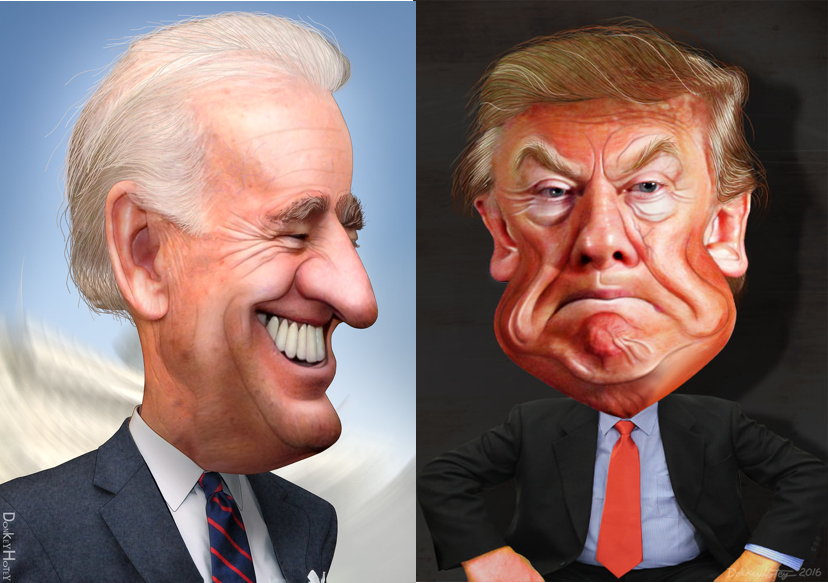
Is Joe Biden an accomplished politician with a strong grasp of foreign affairs, an advocate for the average American, and a president who has accomplished a great deal during his term? Or is he a bumbling, doddering old man who’s out of touch with where America needs to go?
Every aspect of the political landscape is impacted by the perception vs. reality question, whether we’re talking about inflation and the state of the economy, the wars raging between Israel and Hamas, or Russia and Ukraine, and whether democracy or dictatorship is where we’re heading as a country.
So, why anyone thinks that somehow none of this applies to radio is beyond me. For more than two decades, the radio broadcasting industry here in the U.S. has been on its heels, playing defense, and trying to push back rumors of the medium’s imminent demise with evidence to the contrary, namely, radio’s massive reach and its power to influence purchasing habits and put butts in seats.
In fact, the reality is that AM/FM radio is still the biggest audio platform for overall reach and in-car listening, but if most consumers don’t believe these facts, it really doesn’t matter. And when regular folks perceive radio is a has-been, irrelevant, and the credits are rolling, and if advertisers believe very few people under 50 are actually listening, and that radio has lost its mojo, we’re toast.
As perceptions sour, the urge and impetus to listen – at least on an everyday basis – diminishes. And when clients believe their dollars are better spent on Facebook, Google, or TikTok, they will run for the exits. Based on PUMM levels in numerous markets and puny revenue numbers, this process is already underway. And it accelerated during the pandemic.
COVID provided an odd, mandatory break from our lifetime routines. Only a cataclysmic global calamity could fracture longstanding, habitual behavior patterns. And that’s precisely what happened four years ago, and we’re still feeling the effects of it today.
Its onset in 2020 caused millions of us to start re-evaluating everything in their lives – where they live, what kind of work do they do (or do they work at all?), where they work, and when they show up for work. Many have been reassessing their lives – their partnerships, whether to have children, and their sexual identities. Is college still the pathway or are they better served going to trade schools – or any educational institution at all? Where will they live, where will they travel, and how much will they spend in the process? These are all questions on the table.
Sensing this instability, especially from the myriad focus groups we’ve conducted over Zoom these past four years, we took a somewhat different path in the design of Techsurvey 2024 this year. Many new questions were crafted to uncover and pin down these shifting realities and sensibilities. A new series about concert attendance in 2023 revealed that many attended more shows than in the previous year. And perhaps a surprising percentage of concert-goers reported traveling 200 or more miles – one way – to see a favorite performer live and on stage.
We can debate the “reality” of the economy all we like – is it healthy or is it cratering? – but our survey clearly shows consumers – especially young ones – are spending beaucoup dollars on concerts, not just getting there, but also on VIP seating, and merch. For many, money is no object when it comes to enjoying life and entertaining themselves in the here and now:
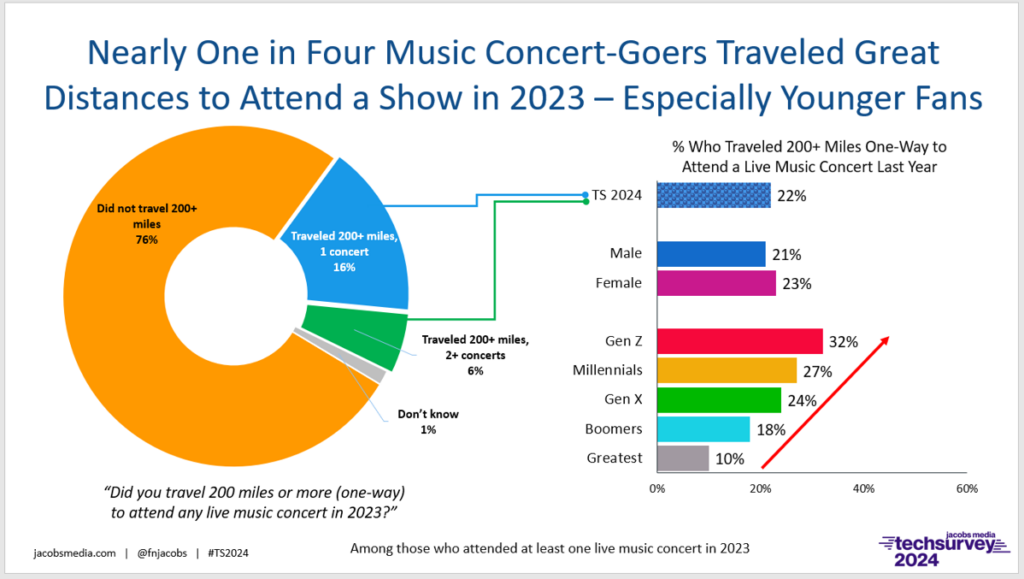
So, with TS24, we tried to cut to the truth about perception vs. reality in the most critically important areas. We know as programmers, sellers, and marketers that if listeners or advertisers don’t buy our claims – or our “truths” – they’re not going to buy US.
I hear frustrated sales managers, directors of sales, radio owners, and C-suite executives whine about the stereotypical media buyer in New York City who commutes to the office via mass transit (or works from home) who believes “no one listens to the radio.” Of course, that’s not true, but perceptions – and the emotions that drive them – often determine decision-making and behaviors.
And you can show a media buyer all the rankers, trends, stats, and pie charts that you like, but if she harbors beliefs – or biases – about the medium, all the facts in the world aren’t going to alter her perceptions. When they harden into concrete, all those negatives about radio become very hard to shake. Students of the game know that in order to change perceptions, you need to both evaluate the product and how you’re marketing it.
Assuming you’re marketing it at all. Because doing nothing and hoping beliefs shift organically is a fool’s errand. Nothing set in stone will magically undergo a mass transformation on a large scale without a concerted effort behind it. Even then, there’s no guarantee if perceptions have been allowed to harden – and fester. Companies and entire industries that waited too long have paid a dear price for their inaction.
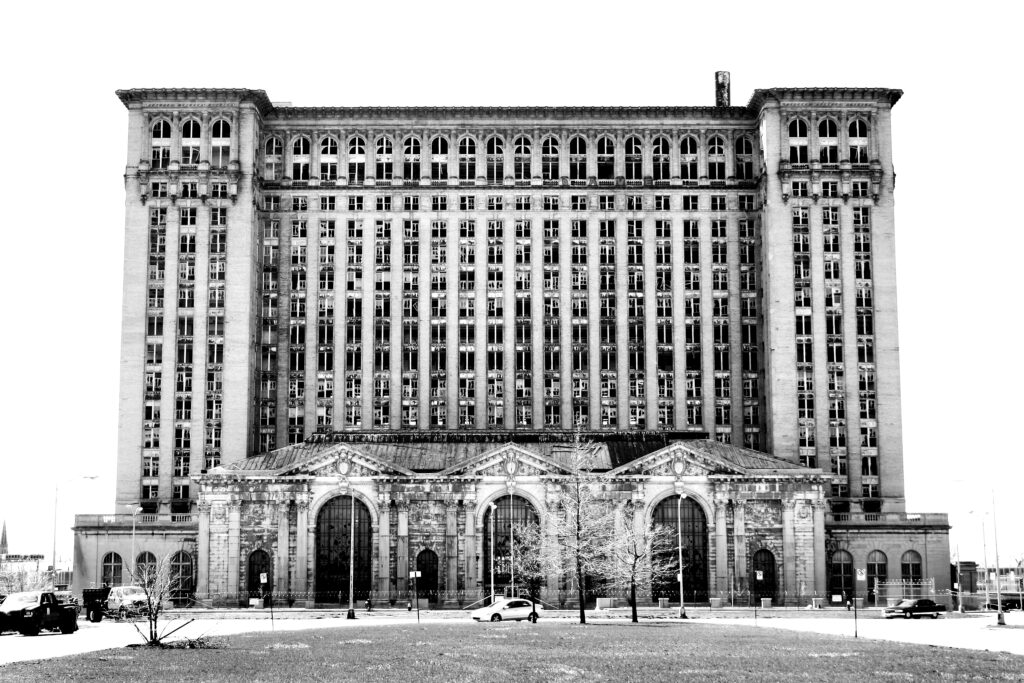
The marketing world is full of brands that lost their way or couldn’t find a way to get it in gear – K-Mart, Oldsmobile, MySpace, Detroit.
Is there any way to come back when you’re staring into the abyss?
In the case of my hometown of Detroit – Motown, the Motor City, we’re watching the renaissance in full bloom. It has required an improved product – notably the Lions and a special head coach, general manager, and an enlightened owner. And of course you have AFDI. This past weekend, the NFL Draft took place in Detroit to record-setting, enthusiastic crowds who personally experienced what it’s like to experience a city on the way back.
Detroit’s turnaround is far from over, but when you think about big American cities in dire straits, you are more apt to name a dozen others before you land here. Perceptions matter – the good ones, the ugly ones, the ones that become entrenched over time. Over the weekend, there were posts, tweets, stories, reels, and videos on all platforms from thousands in attendance, residents and guests alike:
It feels so good to see #Detroit shine in a national spotlight. #NFLDraft https://t.co/sjY9CTCkbn
— Stephanie Steinberg (@Steph_Steinberg) April 25, 2024
None of this is to suggest the work is over. In fact, it’s just beginning. But to change perceptions, brand managers need to take stock of the present, understand the past, and plot out a different future. Of course, that process requires swallowing inconvenient truths, hiring great people, investing in smart initiatives, and doing the work. And sometimes, staring into the abyss.
In Detroit’s case, let’s also not forget the city actually declared bankruptcy in 2013, the biggest municipal filing ever before or since. And two of its biggest companies – GM and Chrysler – were bailed out during the Great Recession a few years earlier. Yes, I was beaming this past weekend watching the NFL Draft, and the smiling faces of hundreds of thousands of out-of-towners enjoying the city. But in Detroit’s case, serious fractures in both perception and reality needed to be addressed in order to arrive at this point.
The economic meltdown here in Motown necessitated local politicians and business leaders coming together to face reality. When you have a common cause and skin in the game, you have no choice but to take action. That’s how the Motor City went from “Murder City” and infamous headlines every Devil’s Night (the evening before Halloween when arsonists lit up neighborhoods every year) to what you saw on TV over the weekend.
action. That’s how the Motor City went from “Murder City” and infamous headlines every Devil’s Night (the evening before Halloween when arsonists lit up neighborhoods every year) to what you saw on TV over the weekend.
Bankruptcy – the poison pill – is a rough one to swallow. And we’re no stranger to it in radio. Paying the piper to this extent requires doing an honest assessment of one’s situation. And in the past couple decades or so, not enough radio broadcasters have been willing to do just that. The result is a diminished product, eroding perceptions, and having to constantly play defense.
Hopefully in radio, we’ll see that opportunity to rebuild, to improve the product, and communicate success. But as the great Robert Cray once said, “The forecast calls for pain.”
That means lost jobs, personal and financial tragedies, creditors, vendors, and suppliers getting stiffed (been there), and other collateral damage that just doesn’t go away by starting a new spreadsheet.
After I wrapped up our Techsurvey 2024 presentation on Thursday, I asked attendees to tell me the one thing that jumped out at them or even surprised them. And while several takeaways emerged, the reality of lowered perceptions toward radio was the standout finding for many of you. Below is the chart that triggered those reactions. It’s a repeat of a question we asked four years prior in Techsurvey 2020:
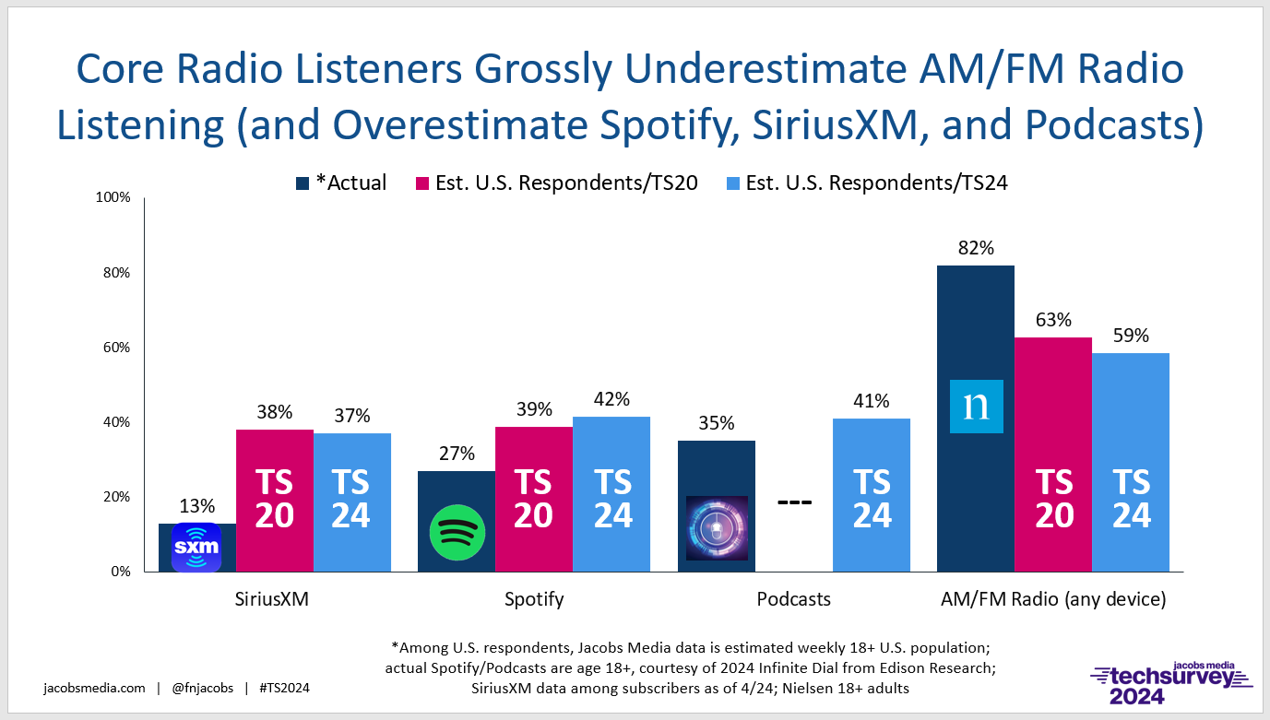
For satellite radio subscribers and weekly 18+ adult listeners to Spotify and podcasts, perceptions of their actual audience size are all bigger than the reality. Spotify, in fact, is making perceptual progress that may be more impressive than their user metrics – or their profits.
But the broadcast radio reality – better put, the perception – is problematic – and getting worse. While Nielsen pegs 18+ adult weekly reach at 82%, perceptions were only at 63% in 2020, and they’ve fallen below 60% this year.
(And for those of you who wish to take me to task because you believe radio’s true reach remains closer to 90%, be careful what you wish for. Even if that was the case, it doesn’t change this year’s “perception” levels, only making a wider gap look shockingly worse.)
And let’s not forget who these 31,000+ people are – mostly core fans of broadcast radio (or they were at one time). Imagine what an unvarnished sample encompassing everybody might have shown.
 The truly sad part is that like Detroit, many consumers have a soft spot for radio. They grew up with it, (probably) still listen, and have deep feeling of nostalgia for the medium.
The truly sad part is that like Detroit, many consumers have a soft spot for radio. They grew up with it, (probably) still listen, and have deep feeling of nostalgia for the medium.
Radio’s nostalgic piece is important because few of us have warm, childhood memories of growing up with Spotify, podcasts, or satellite radio. Broadcast veterans know the power of nostalgia. Hell, my claim to fame as a consultant was built on it. And in fact, some of the most successful products, personalities, and destinations today are steeped in the power of nostalgia.
You can’t buy it, just as you cannot artificially age a brand or a wine. That time in grade, giving people experiences and positive memories is what separates sports teams. No matter how poorly they may play in any given year, the Yankees, Lakers, and Cowboys have a distinct advantage over the Rays, the Hornets, and the Jaguars. Fans will always be fair-weather – what have you done for me lately? – but brands that have a nostalgic foundation, the ones you enjoyed going to games with dad or back in college, are the ones you’ll buy merch for and follow on any given Sunday…or Thursday night.
And so it is with radio. I have written numerous posts about tech companies, in particular, trying to appropriate radio’s nostalgic glow – Apple, Spotify, Amazon, a gazillion podcasters, and satellite radio at pretty much every turn. While there have been occasional glimmers of success, most of these efforts to recapture the best of what radio meant to people fall on deaf ears. They are facsimiles of the real thing, in the same way AI DJs cannot possibly match up to a warm, wonderful, clever personality who knows how to spin a great story.
Simply put, the fond, seminal, fun memories and feelings that millions of Americans still have for the radio they grew up with are largely intact. Many may be bothered or even disappointed by the current offerings on the AM/FM bands, but north of 80% of adults are still stopping by, hoping to hear something interesting, informative, entertaining, or different.
And the nostalgic vibe of radio is still in place. Last week, my friend, ex-boss, and mentor Tom Bender sent me an offering from Christie’s, the world famous auction house. The artist is Ed Ruscha whose “text paintings” have sold for north of $52 million. Ruscha (pronounced rew-shay) typically combined words with painting and photography to convey a mood or a vibe.
An artist known for his work in the 1960’s when icons like Andy Warhol and Roy Lichtenstein ruled the world of art, Christie’s is highlighting a work by Ruscha called “Hurting the Word Radio #2” created in 1964. Here’s the brief video they posted:
In many ways, the nostalgic pings millions of Americans still get from radio have similarities to the conditions that helped bring vinyl back from the recorded music dead. There is a tactile, expansive aspect to this old music format you simply cannot get from digital music. You own an album in a world where you simply used a file, and then scroll down to whatever’s next.
But I would also argue that vinyl has been marketed over the last many years. National Record Store Day – created in 2008 – and associated events were created to embellish and champion this music form,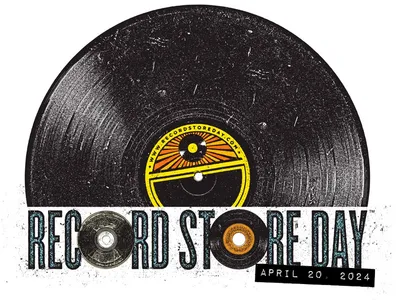 again powered by the collective memories we have of 45’s, turntables, album art, liner notes, and the other trappings always a part of this platform.
again powered by the collective memories we have of 45’s, turntables, album art, liner notes, and the other trappings always a part of this platform.
Ultimately, a comeback of this proportion – and the possibility of something on the same scale happening for radio – hinge on the quality of the product (yup, there’s a catch) and the way it is marketed to radio lovers of the past and potential future fans alike.
And we know that marketing, visibility, and buzz matter very much in vaulting any product into our collective consciousness. Here’s a small, but perhaps telling example.
Every year in Techsurvey, we ask those looking to buy or lease a new vehicle in the calendar year to evaluate a list of “must have” features revolving around infotainment. In recent years, the big story is how Bluetooth now outranks FM radio in importance – even among these radio partisans. And that’s the case once again this year.
A number of years ago we decoupled AM radio from its younger sister, FM, and had respondents rate them separately And as a result, good old amplitude modulation has typically dropped in importance with each passing survey.
Until this year.
Both AM and FM radio jumped 3 points year over year. For FM, this isn’t especially remarkable. But for AM radio, in the midst of what many perceive as a death spiral, a gain in prominence and perception is worthy of a high five or two, or at least an elbow bump.

But why did it happen? Has AM radio actually improved over the past year? Hardly.
Yet, AM has been marketed….sort of. The story about the band being excluded from new cars, EVs and internal combustion vehicles, was well-covered in the media. Further, a number of AM (and FM) stations, in particular, took to their own air (and websites and social media pages) to tell the story of this existential threat to this historic medium.
Hundreds of “radio ambassadors,” mostly from state broadcasters associations, NASBA (National Alliance of State Broadcasters Association), and the NAB converged on the nation’s capital to lobby legislators. And in the process, awareness for the plight of AM radio in cars grew. Not only did we see it in Techsurvey, but many of us have heard it anecdotally from concerned friends and family members wondering why automakers are threatening to omit radio from their dashboards.
Who knows how many millions of gross impressions there were in 2023, but we know it totally eclipsed any talk or promotion of AM radio in all previous years. And the message apparently got through.
Earlier this month, I wrote a post that seemed to resonate with many of you – “When Did Radio Stop Advertising?” – that covered much of this ground. I even came up with a couple of marketing strategies the industry might consider in an effort to turn negative perceptions around – or at least slow them down.
 Some of you commented at that time that it doesn’t make sense to market a product that’s not very good or even ready for “prime time.” But I would suggest the longer you’ve been listening to radio, the harder it will naturally be for today’s product to match up to your memories of growing up with different music, personalities, and brands from your past.
Some of you commented at that time that it doesn’t make sense to market a product that’s not very good or even ready for “prime time.” But I would suggest the longer you’ve been listening to radio, the harder it will naturally be for today’s product to match up to your memories of growing up with different music, personalities, and brands from your past.
I think it’s also true that perceptions of how radio sounds today depend greatly on who you are, where you live, your age, and your collective media experiences. Subjectively, there are some markets where radio simply sounds better. Or metros where a number of stations still compete aggressively on several different levels. Sometimes, smaller markets may be doing some of the best radio, flying in the face of conventional wisdom to the contrary.
The idea of marketing a product (or an industry) before it’s ready is antithetical to everything I’ve learned in this business. If you’ve been at this for awhile, you’ve seen what happens when you run ads for a radio station that’s not very good. Usually, it’s a gigundous waste of money. So, I am not suggesting broadcasters just leave a mediocre product alone. Take the opportunity to improve it in any way you can.
So my prohibitive recommendation to market radio – to do something – is designed to create more positive perceptions, greater awareness, and even tune-in and sampling. I would also make the case that when a brand is “out there” promoting its assets, good things can happen as a result.
I’ll end with an interesting but perhaps telling example. While scrolling through Twitter/X the other day, I came across a tweet from “The Dave & Chuck the Freak Show,” headquartered at Beasley’s WRIF here in Detroit:
Shout out to our friends @chrysler that are fans of the show! pic.twitter.com/RMDNudKEuI
— Dave&ChuckTheFreak (@DaveandChuck) April 12, 2024
The fact this morning show appeared in an unlikely place – not a TV spot, billboard, or other traditional advertising venue – makes it potentially even more effective. You’re not expecting to see a “radio impression” while perusing a car’s manual trying to find the gas cap release. Given the thousands of metro Detroiters who buy or lease new Chrysler products this year, these are some nice impressions for a broadcast radio team. The fact the show is syndicated in markets that include Boston, Tampa, Saginaw, Las Vegas, and others means car buyers in those towns will see their morning show in owner’s manuals, too.
Marketing exposure – if it’s smart, timely, and you get a little lucky – begets even more exposure. In some way, this is “earned media” of the best kind.
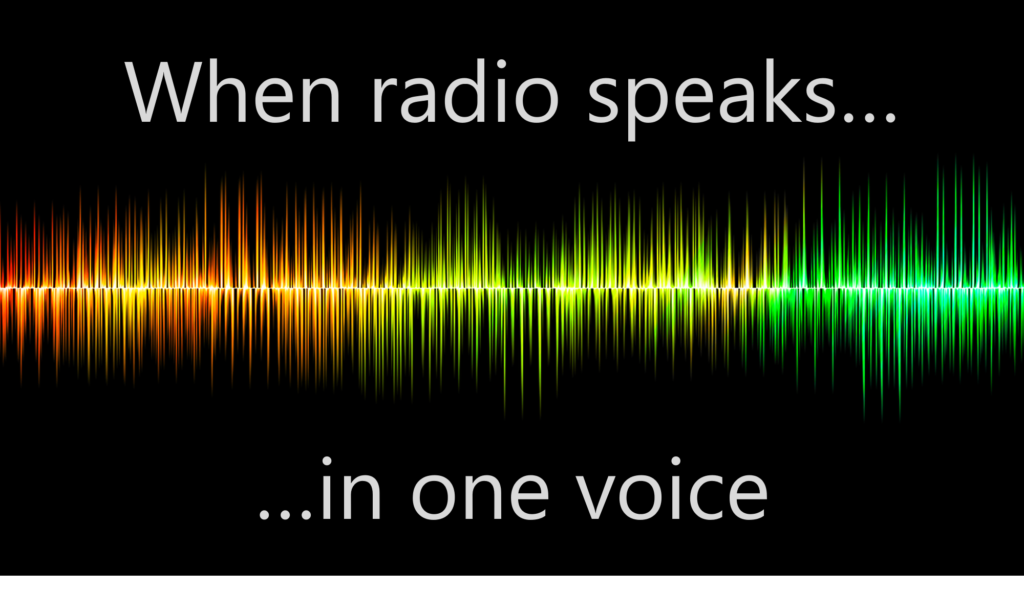 And that’s the assessment the powers that be in radio ought to be considering. It is challenging for them to put down their swords and work together for their common good, but that’s what meeting the moment may be about in 2024.
And that’s the assessment the powers that be in radio ought to be considering. It is challenging for them to put down their swords and work together for their common good, but that’s what meeting the moment may be about in 2024.
There’s precedent for it working. The “Save AM” campaign was truly a collective effort, a rare moment in time when the broadcast radio industry here in the U.S. actually spoke with one voice.
Let’s do it again.
P.S. A look at Detroit’s renovated train station by Ford, set to reopen soon.
Ford purchased the old, abandoned Michigan Central train station in Detroit in 2017 for $90 million. It has reportedly spent $740 million to restore/renovate it.
It is set to reopen this June.
I’m very curious to see what it looks like. pic.twitter.com/Bje546sjJp
— Kevin – Classical Liberal 🇺🇸 (@gov_fails) April 4, 2024
P.P.S. If you’re interested in learning more about the artist, Edward Ruscha – who is still alive – this short video by Karen Bruer, curator of the Fine Arts Museums of San Francisco is entertaining and fascinating.
- Attention Tech And Entertainment Writers: Don’t Mess With Radio! - May 15, 2025
- 3 Socio-Economic Shifts Every Radio Programmer And Seller Should Be Aware Of - May 14, 2025
- “It Was The Dumbest Contest In Radio History” - May 13, 2025




This column is an essay on a myriad of examples of changed perceptions. Well done Fred! Hopefully your points will stimulate action within the radio industry.
Quite the article. Thank you, Fred. Radio has life. We all do.
Fred, you said it….and I believe the focus on “reach” is part of the problem. The radio is in the car, it may even be on, but the listening experience has become more vanilla without memorable moments. I have first hand experience now with consumers who get totally bent out of shape if their Bluetooth, or CarPlay connections fail, but barely notice if the wheels fall off the car. That experience they get with those things is meaningful to them. Their perception is that radio is just a bunch of songs with too many commercials and few reasons to glue them to it, I hear it when I ask about setting things up when they acquire a vehicle. I spend almost all of my time with them explaining the center stack. But unfortunately, it’s very rare anyone asks about the “radio”. The focus on reach makes for a good headline, but are people really hearing what’s there? It sounds so basic, but it’s all relative to a listener, and we just don’t offer enough reasons to tune in, other than the fact that it’s there and free. (And by the way, our hometown there is getting lots of attention finally…it’s a result of that cool stuff going on there you talked about…not just reach).
There was a comment posted some time back on the superb Hobbybroadcaster.Net site (dedicated to Part 15 legal microbroadcasting), where local AM signals that had gone dark became repopulated by flea-power broadcasters, interested in keeping legacy dial positions alive: “It’s still AM radio, but it’s like taking an old abandoned railroad line and giving it new life as a bike trail.”
It may not be the WXXX we all grew up with, but the legacy lives on.
Perhaps it’s better to think of this as at least somewhat of a public-relations issue than solely a marketing (or branding) issue.
Somewhat along those lines, here’s a recent profile of Detroit-related efforts (which includes some quotes from the CEO of a locally based PR firm)…
https://www.prnewsonline.com/detroits-renaissance-rebranding-a-reputation
Fred,
Appreciate your straight forward critique. I started my career in radio sales, moved over to television for over a decade and then back into the radio space the last 10 years. And it has been a nightmare. I’ve worked in small to large markets. What I heard 30 years continues to be the same drivel today. Especially from leadership of the large radio broadcast groups. From a sales perspective virtually every market and company I have worked for programs generically, voice tracking with DJs across multiple different formats so there’s no uniqueness to the personality and some can’t perform in other genres, adheres to consultants dinosaur practices, combines every function they can from morning shows across multiple markets to traffic/business departments. I get the consolidation for some things however they think it’s the answer to everything. With most radio groups sales training is non-existent or frowned upon. And the managers are never coached. I worked for one television group that invested in their leadership/managers at the local level by coaching the coaches. As an industry we hire people and throw them on the street with little to no direction or training/preparation and expect good performance. I can’t tell you how many times I sit in sales meetings and hear the same attacks on the other mediums as if radio is the golden boy…which it’s not. Most sales departments have no support. AEs are responsible to enter orders, write copy and everything else that doesn’t lead to the next sale. You look at other industries that rely heavily on sales performance and those industries support their teams.. Ie: insurance, medical etc. We ourselves are are own worst enemy. Continue to do the same thing and expect different results. Bankrupt a company and never change to ensure performance gets better. I could go on and on. I think you get the picture.